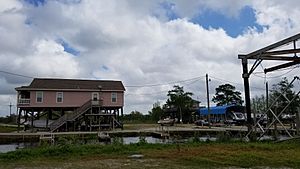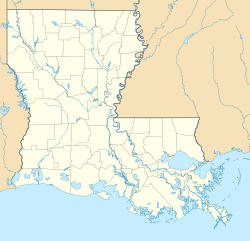Reggio, Louisiana facts for kids
Quick facts for kids
Reggio
Bencheque
|
|
|---|---|

Raised houses of the community along the Reggio Canal.
|
|
| Country | |
| State | |
| Parish | |
| MCD | Parish Governing Authority District E
|
| Historic colonies | Louisiana (New Spain) Louisiana (New France) |
| Established | 1783 |
| Named for | Louis de Reggio; Montaña y Barranco de Bencheque |
| Area | |
| • Total | 13.1 km2 (5.06 sq mi) |
| Elevation | 0.9 m (3 ft) |
| Demonym(s) | benchecano, -na |
| Time zone | UTC−6 (Central) |
| • Summer (DST) | UTC−5 (Central) |
| ZIP code |
70085
|
| Area code(s) | 504 |
| GNIS feature ID | 1628038 |
Reggio (pronounced REJ-ee-oh), also known as Bencheque (pronounced ben-CHEK-ay), is a small fishing community in St. Bernard Parish, Louisiana. It was founded in 1783 by settlers from the Canary Islands. These settlers, known as Isleños, built their homes along Bayou Terre-aux-Boeufs.
Later, in the late 1700s, a man named Louis de Reggio bought land from the Isleños. He started a large sugarcane farm, called a plantation, in the area. Reggio is special because it might be the only place in the United States with a name from the ancient Guanche language.
After the American Civil War, more Isleños moved to the eastern part of the Parish. They focused on activities like fishing, trapping, and hunting. Over time, things like new roads and modern ways of life caused many Isleños to move away from their traditional communities. After Hurricane Katrina hit in 2005, only a few original families returned to rebuild their homes.
Contents
What's in a Name? Reggio and Bencheque
The community has two main names: Bencheque and Reggio. Both names have interesting stories behind them.
The Original Name: Bencheque
The first name, Bencheque, comes from a mountain and a valley on the island of Tenerife. Many of the original settlers from the Canary Islands came from this area. The name "Bencheque" comes from the Guanche language. It is thought to mean "the place of the trees" or "the plant place." People from this community are sometimes called Benchecanos.
How the Name Reggio Came About
The name Reggio comes from Louis de Reggio. He owned the large sugarcane plantation in the same area. For a long time, people saw the Reggio plantation and the Bencheque community as two separate places.
Even today, many Isleños, especially those who speak Spanish, still remember this difference. However, official groups like the United States Geological Survey (USGS) often use "Reggio" to refer to the whole area. Legal papers for land in the settlement still use the name Bencheque.
A Look Back: The History of Reggio
The history of Reggio is closely tied to the Spanish settlers and the challenges they faced.
Early Days: Spanish Settlers Arrive
Starting in 1779, the Spanish government helped Canary Islanders settle along Bayou Terre-aux-Boeufs. This area later became St. Bernard Parish. The whole settlement was called the Población de San Bernardo. It was made up of smaller communities, or establecimientos. These communities stretched along the bayou. One of the larger communities, founded in 1783, was the "fifth establishment," which became known as "Bencheque."
Plantations and New Connections
In the 1790s, Louis de Reggio from New Orleans bought land from the Isleños. He started a sugar plantation that grew quite large. In 1836, the Mexican Gulf Railroad was built. This railroad connected the Reggio plantation and other farms in St. Bernard Parish to the city of New Orleans. After the American Civil War, more Isleños moved to Bencheque. They came to fish, trap animals, hunt, and gather Spanish moss. While other parts of Louisiana changed, the Isleños in Bencheque largely kept their traditional rural way of life.
Facing Hard Times: Natural Disasters and Changes
The 1900s brought many difficulties for the benchecanos.
- The 1915 New Orleans hurricane caused a lot of damage. Many Isleños died, and almost every house in Bencheque was destroyed.
- Two years later, the Spanish flu spread through St. Bernard Parish. It led to the burial of over a thousand people, mostly Isleños.
- The Great Mississippi Flood of 1927 also caused problems. A levee was intentionally broken at Caernarvon, which flooded the community completely.
Over time, more people moved to cities for jobs and better opportunities. Better roads and more access to education also encouraged residents to leave. In 1965, Hurricane Betsy hit Louisiana. It again destroyed homes in the community. This event greatly impacted the Isleño culture in the area. In 2005, Hurricane Katrina caused massive damage. Only a few of the original families came back to rebuild, and new families moved into the available properties.
Images for kids




